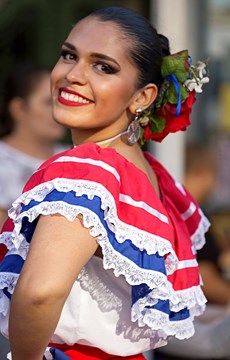Love it or leave it, Costa Rica a truly cool place to live in or visit. A small country, Costa Rica has perfect the ‘Pura Vida’ or pure life that is different for everyone.
- Costa Rica hosts more than 5% of the world’s biodiversity even though its landmass only takes up .03% of the planets surface.
- Costa Rica is officially the Republic of Costa Rica (Spanish: República de Costa Rica).
- Costa Rica was sparsely inhabited by indigenous people before coming under Spanish rule in the 16th century. It remained a peripheral colony of the empire until independence as part of the short-lived First Mexican Empire, formally declaring independence in 1847.
- Costa Rica has remained among the most stable, prosperous, and progressive nations in Latin America.
- Following the brief Costa Rican Civil War in 1948, it permanently abolished its army becoming one of only a few sovereign nations without a standing army.
- Costa Rica also has progressive environmental policies. It is the only country to meet all five UNDP criteria established to measure environmental sustainability.
- Costa Rica plans to become a carbon-neutral country by 2021. By 2016, 98.1% of its electricity was generated from green sources particularly hydroelectric, solar, geothermal and biomass.
- The name la costa rica, meaning “rich coast” in the Spanish language, was in some accounts first applied by Christopher Columbus, who sailed to the eastern shores of Costa Rica during his final voyage in 1502.
- Like the rest of Central America, Costa Rica never fought for independence from Spain.
- Coffee was first planted in Costa Rica in 1808. By the 1820s, it surpassed tobacco, sugar, and cacao as a primary export. Coffee production remained Costa Rica’s principal source of wealth well into the 20th century.
- Costa Rica comprises 51,100 square kilometres (19,700 sq mi) plus 589 square kilometres (227 sq mi) of territorial waters.
- Costa Rica’s marine area reaches 580,000 square kilometers, approximately 10 times larger than its land area.

The smoldering Turrialba Volcano. Photo: gailhampshire - The highest point in the country is Cerro Chirripó, at 3,819 meters (12,530 ft); it is the fifth highest peak in Central America.
- The highest volcano in the country is the Irazú Volcano (3,431 m or 11,257 ft) and the largest lake is Lake Arenal.
- There are 14 known volcanoes in Costa Rica, and six of them have been active in the last 75 years.
- The country has also experienced at least ten earthquakes of magnitude 5.7 or higher (3 of magnitude 7.0 or higher) in the last century.
- Costa Rica also comprises several islands. The Isla del Coco or Cocos Island (24 square kilometers) stands out because of its distance from the continental landmass, 480 kilometers from Puntarenas, but Isla Calero is the largest island of the country (151.6 square kilometers).
- Over 25% of Costa Rica’s national territory is protected by SINAC (the National System of Conservation Areas), which oversees all of the country’s protected areas, the largest percentage of protected areas in the world (developing world average 13%, developed world average 8%).
- Costa Rica possesses the greatest density of species in the world.
- Costa Rica’s climate is tropical year round. However, the country has many microclimates depending on elevation, rainfall, topography, and by the geography of each particular region.
- Costa Rica’s seasons are defined by how much rain falls during a particular period. The year can be split into two periods, the dry season known to the residents as summer (verano), and the rainy season, known locally as winter (invierno).
- TheCaribbean slopes of the Cordillera Central mountains, has an annual rainfall of over 5,000 mm (196.9 inches or 16.4 feet)
- Costa Rica stands as the most visited nation in the Central American region,[104] with 2.9 million foreign visitors in 2016, up 10% from 2015.
- Costa Ricans refer to themselves as “Ticos” (males) and “Ticas” (females).
- Though Costa Rica has its own currency (the Colon), the US dollar is commonly used in retail stores, rents, and prices of vehicles, for example.
- There are about 52 species of hummingbirds in Costa Rica, making Costa Rica a true hummingbird capital.
- Monkeys are one of the most common mammals in Costa Rica – next to bats.
 Costa Rican women do not take their husbands’ last name when they get married. They keep their maiden name for life along with their mother’s maiden name.
Costa Rican women do not take their husbands’ last name when they get married. They keep their maiden name for life along with their mother’s maiden name.- Called the grano de oro (grain of gold), coffee was Costa Rica’s foremost export for 150 years until tourism surpassed it in 1991. More than 247,104 acres of coffee is planted in Costa Rica, making it the 13th largest coffee exporter in the world.
- Costa Rica is the second largest exporter of bananas in the world after Ecuador.
- In Costa Rica, a discoteca is a nightclub, and a nightclub is actually a strip club.
- In Costa Rica, speed bumps are called topes or muertos (dead persons).
- Costa Rica’s Escazú is famous for witchcraft where, historically, people took to mountain caves to secretly practice their religious and magical rituals.
- Robert Louis Stevenson’s novel Treasure Island is thought to be modeled on Costa Rica’s Isla del Coco.
- Costa Rica’s largest body of freshwater is the manmade Lake Arenal.
